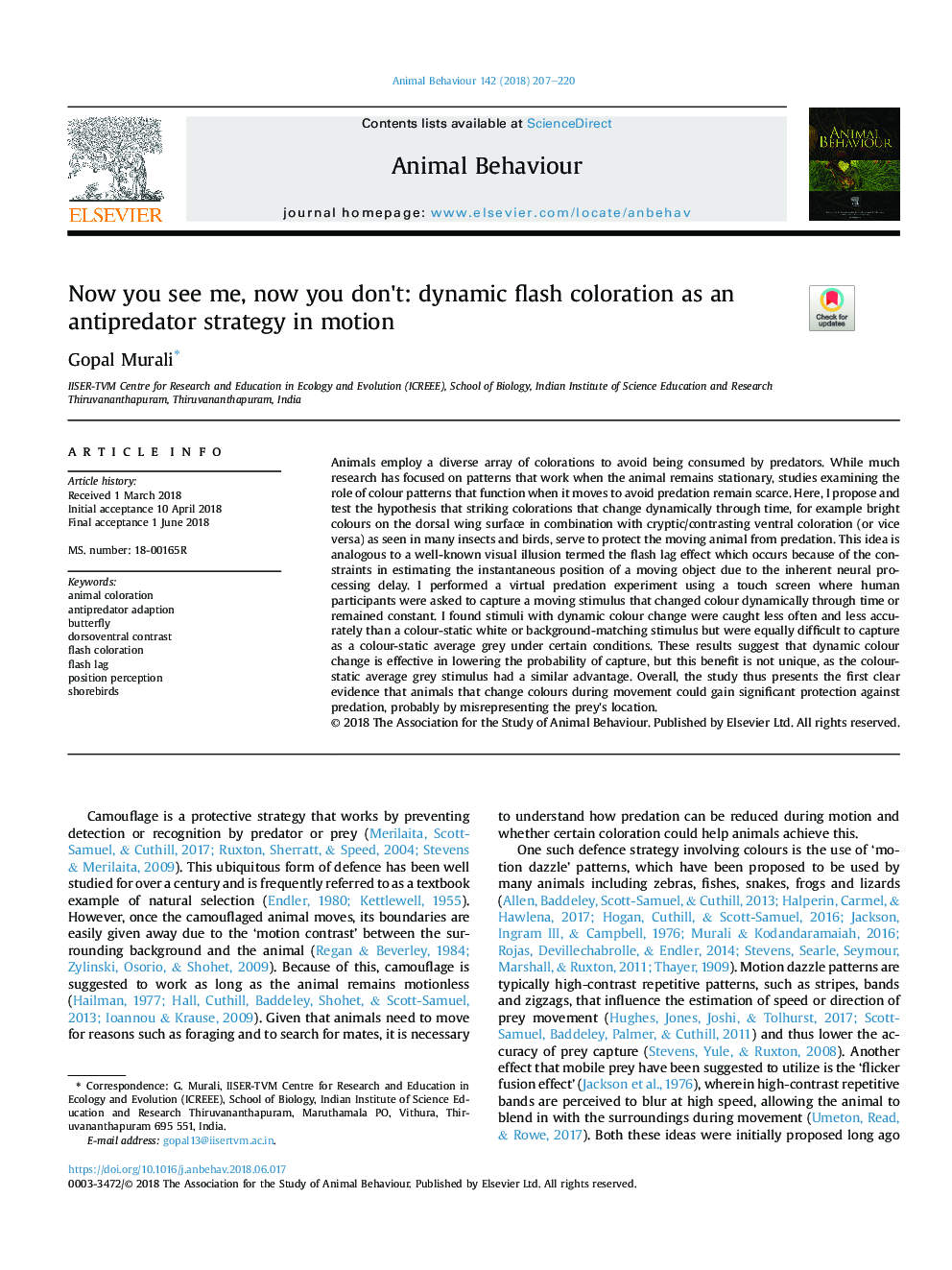| کد مقاله | کد نشریه | سال انتشار | مقاله انگلیسی | نسخه تمام متن |
|---|---|---|---|---|
| 8488448 | 1552186 | 2018 | 14 صفحه PDF | دانلود رایگان |
عنوان انگلیسی مقاله ISI
Now you see me, now you don't: dynamic flash coloration as an antipredator strategy in motion
ترجمه فارسی عنوان
حالا من را می بینید، حالا شما نمی گویید: رنگ آمیزی فلش پویا به عنوان یک استراتژی ضد مهاجم در حرکت است
دانلود مقاله + سفارش ترجمه
دانلود مقاله ISI انگلیسی
رایگان برای ایرانیان
ترجمه چکیده
حیوانات طیف وسیعی از رنگ ها را برای جلوگیری از مصرف شکارچیان استفاده می کنند. در حالی که تحقیقات زیادی روی الگوهایی که زمانی که حیوان باقی می ماند ثابت می شود، تمرکز دارد، مطالعات بررسی نقش الگوهای رنگی که در هنگام حرکت برای جلوگیری از شکار در آنها کار می کند، هنوز کم است. در اینجا، من پیشنهاد و آزمون فرضیه که رنگ آمیزی که تغییر از طریق زمان به طور پویا تغییر می کند، به عنوان مثال رنگ های روشن بر روی سطح بال عقب در ترکیب با رنگارنگ شفاف / مخالف (یا برعکس) که در بسیاری از حشرات و پرندگان دیده می شود، حیوان متحرک از شکارچیان این ایده مشابه یک توهم شناخته شده شناخته شده است که اثر تأخیر فلش را نامیده است که به علت محدودیت در تخمین موقعیت لحظه ای یک شی متحرکی به دلیل تاخیر پردازش عصبی ذاتی رخ می دهد. من با استفاده از یک صفحه لمسی یک آزمایش مجازی شکارچی انجام دادم که در آن شرکت کنندگان در انسان از یک محرک حرکتی که از طریق زمان به صورت پویایی تغییر کرده بودند یا از طریق تغییر رنگ تغییر یافت یا ثابت باقی ماند. محققان دریافتند که محرک های تغییر رنگ پویا کمتر و ضعیف تر از محرک رنگ سفید استاتیک یا مطابقت با پس زمینه گرفته شده اند اما به همان اندازه مشکل است که در شرایط خاصی به رنگ خاکستری تبدیل شود. این نتایج نشان می دهد که تغییر رنگ پویا در کاهش احتمال جذب مؤثر است، اما این مزیت منحصر به فرد نیست، زیرا محرک متوسط خاکستری رنگی دارای مزایای مشابه است. به طور کلی، مطالعه به این ترتیب اولین شواهد واضح را نشان می دهد که حیواناتی که تغییر رنگ در حین حرکات می توانند حفاظت قابل ملاحظه ای در مقابل شکارچیان ایجاد کنند، احتمالا با اشتباه بودن محل شکار.
موضوعات مرتبط
علوم زیستی و بیوفناوری
علوم کشاورزی و بیولوژیک
علوم دامی و جانورشناسی
چکیده انگلیسی
Animals employ a diverse array of colorations to avoid being consumed by predators. While much research has focused on patterns that work when the animal remains stationary, studies examining the role of colour patterns that function when it moves to avoid predation remain scarce. Here, I propose and test the hypothesis that striking colorations that change dynamically through time, for example bright colours on the dorsal wing surface in combination with cryptic/contrasting ventral coloration (or vice versa) as seen in many insects and birds, serve to protect the moving animal from predation. This idea is analogous to a well-known visual illusion termed the flash lag effect which occurs because of the constraints in estimating the instantaneous position of a moving object due to the inherent neural processing delay. I performed a virtual predation experiment using a touch screen where human participants were asked to capture a moving stimulus that changed colour dynamically through time or remained constant. I found stimuli with dynamic colour change were caught less often and less accurately than a colour-static white or background-matching stimulus but were equally difficult to capture as a colour-static average grey under certain conditions. These results suggest that dynamic colour change is effective in lowering the probability of capture, but this benefit is not unique, as the colour-static average grey stimulus had a similar advantage. Overall, the study thus presents the first clear evidence that animals that change colours during movement could gain significant protection against predation, probably by misrepresenting the prey's location.
ناشر
Database: Elsevier - ScienceDirect (ساینس دایرکت)
Journal: Animal Behaviour - Volume 142, August 2018, Pages 207-220
Journal: Animal Behaviour - Volume 142, August 2018, Pages 207-220
نویسندگان
Gopal Murali,
